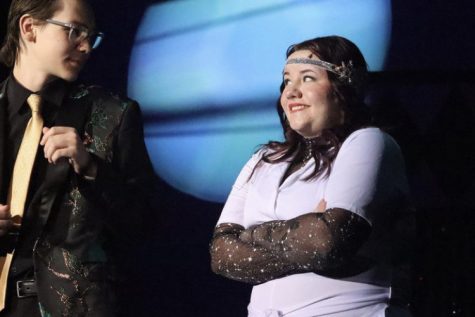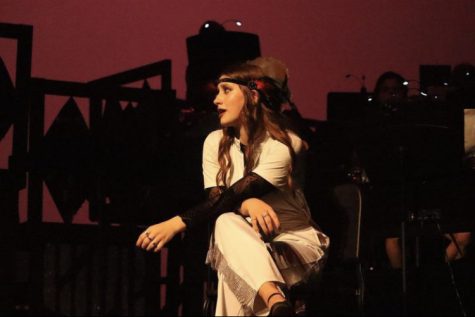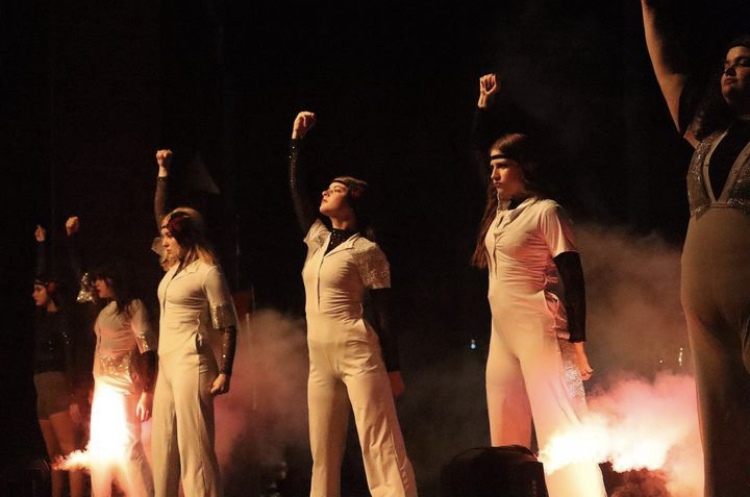Chicago: Glenn Theatre’s Loftiest Ambitions Pay Off In Style
January 26, 2023
From the moment lights come up on Velma Kelly, played by Savannah Baker, Chicago’s greatest celebrity convict, it is made clear through every snap, shimmy and whisper that Chicago is a show about style. That style, manifested through production design and colorful performances, is the main throughline in the entire show, weaving itself into every sector of production. If anything, it is the cause of highest of highs as much as of the rare faults the musical falls into.

Chicago, a 1970s musical classic originated on Broadway by Bob Fosse, tells the story of Roxy Hart, played by Lexi Lambrecht. Hart, a desperate housewife lost in 1920s Chicago’s matriarchal criminal world, descends into a jungle of scandals and fame as an allegory of America’s sensational tendencies toward true crime.
Along the way, she meets the colorful characters that make up the great ensemble, with untrustworthy figures like “Mama” Morton, played by Delaney Paladino, the head of Cook County jail’s convict family along with Billy Flynn, played by Tye Vasquez, a charmingly sleazy lawyer dead-set on taking any case that will get him both money and notoriety.
The entire cast relishes in their roles, but it is standouts like the aforementioned Vasquez as Billy Flynn and Paladino as “Mama” Morton that give the production the tongue-and-cheek moments it needs. Other cast members, like Savannah Baker as Velma Kelly, are given surprisingly small amounts of content in the script for their otherwise intriguing characters, but still find moments to give needed weight to their backstories, even if just in a single look of despair to the audience.

The beauty of Chicago is that, if any aspect of the production falters, the others are held up to support the show’s vision where some cannot. For example, any confusion as to the nature of a character’s motives is cleared by the color of their costume, whether through the hughes of gold and green in Billy Flynn’s suit signifying his greed and need for money, or the black and white colors of the main criminals’ prison-wear displaying the contrast between their sins and their purity.
The only real gripe with Glenn’s production is with the script itself. Given the emphasis on both time period and relevance, the original text lends itself to great satire on the woes of American culture, but Glenn’s production is much more about the glitz and glam that comes along the way. Still, there are several moments that reframe the 1920s setting into the modern age, including a live twitter feed and a fourth-wall-breaking callout to the audience, that address the message of the entire musical: that for the commercialization of murderers and criminals in America, we are to blame.
In terms of the production design, every single bit of detail on the set, lights, and sound adds to the cohesive vision of the world of Chicago. Throughout the set are all kinds of clear-cut shaped diagonal figures in the show’s colors of red and silver, creating a geometric feel that reflects the precision to every single dance move the actors make.
What is even more surprising is the inclusion of audio/visual elements and the live band. As opposed to boring linear exposition, Glenn’s production shows footage of characters showing their backstories instead of telling them. These shots, filmed and edited by Jo Dohring, give extra dimension to the characters with flourish and style. As for the band, arguably the strongest aspect of production, every note of music serving background to the songs is live played by Glenn band members. Every moment is played in beautiful harmony, and keeps the instrumental fresh.
Overall, Chicago is at its best when it embraces its tone to create a chaotic symphony, a beautifully immersive collage of the audio-visual mediums of film, music and theatre. If anything, it means more for Glenn at large that so many sectors of its culture, being band, theatre, dance and more are able to come together and be part of something larger. Surely, this is only a step into a future of harmonious collaboration for Glenn’s theatre production.


